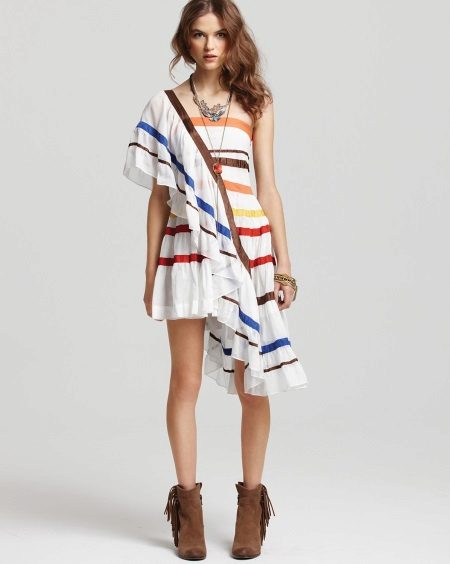For a hot summer, you can’t find a more comfortable outfit than a dress made of light fabric, such as a cambric. Batiste is the thinnest, translucent material that is made from flax or cotton fibers.

The highest quality cambrica cloth is woven in selected areas of Belgium and France - there are still preserved ancient methods of making cambrica, which allows to obtain incredibly thin and strong fabric. Interestingly, the birthplace of the cambric is considered to be Belgium, or rather the county of Flanders, where this material has been produced since the 18th century.



In this article, we will tell you about batiste dresses: their advantages and disadvantages, fashionable styles, and also give some recommendations for caring for batiste products.


Pros and Cons of Batista
First, let's talk about what qualities of this unusual material give it advantages, and which ones speak not in its favor.
So, among the main advantages of a cambric, the following can be distinguished:
- does not fit the figure, therefore, allows free movement;
- perfectly passes air, it is not hot in it;
- forms beautiful folds and drapery;
- pleasant to the touch;
- it keeps its shape well, does not deform after washing;
- hesitates very weakly;
- does not need careful leaving;
- has a low cost.



The list of shortcomings of the cambric will be as follows:
- This fabric looks quite simple, so batiste dresses are not suitable for especially special occasions;
- needlewomen often complain that it is difficult to cut from a cambric cloth, since it is too light.

Structure
Today in stores you can find dresses from several different types of cambric:
- cotton;
- linen;
- synthetic.



The first two varieties of batista are completely natural materials, and the last is a fabric of artificial origin.

Qualitative characteristics and cost of a natural cambric cloth will be significantly higher than that of a synthetic one.

In descriptions, a term such as "mercerized cambric" is often found. It denotes the highest quality fabric, which is achieved by treating the fibers with sodium hydroxide, followed by washing in hot and cold water. As a result of these procedures, the canvas becomes silky, gaining strength and the ability to absorb moisture.

Styles
Batiste dresses are a type of summer clothing, so they usually look very simple and concise. This material is beautifully draped, so dresses with airy, fluffy skirts are often sewn from it.



Layered cambric skirts with ruffles or ruffles make the female figure look like an exotic flower.



Loose sundresses and tunics from batista - incredibly beautiful and delicate outfits for warm weather. Since the cambric is well painted, the designers do not limit their imagination by releasing collections of cambric dresses in bright, saturated colors.

In the shops you can find a dress from a cambric, in which you can appear in the office without breaking the dress code. For this case, you need to choose an outfit from a more dense fabric, a straight and slightly flared cut, with a shallow neckline.


Summer options
In the summer, we can finally afford what we have been doing for several cold months - light, open dresses. For such a case, a cambric is the most suitable material. A snow-white dress that exposes the shoulders will beautifully set off the tan, and outfits of bright colors, with unusual patterns and ornaments can distinguish you from the crowd.



For the summer, models with a floor skirt are especially good, which not only beautifully lengthen the silhouette, but also protect from the sun. Shortened cambric dresses are convenient for summer days, saturated with vigorous activity. They will not constrain movements and allow your legs to become covered with a golden tan.

Care
- Batiste products should be washed manually or in a washing machine in the delicate washing mode.
- It is better to wash cambric dresses and other clothes separately from things sewn from other types of fabrics.
- When ironing dresses from cambric, you need to translate the iron into "linen" or "cotton" mode; In addition, cheesecloth is recommended.
- If you need to sew a dress from a batista, use the thinnest needle and thread, otherwise the punctures will be noticeable.
- You can bleach and remove stains from batiste dresses, but only with the help of special products for delicate fabrics.













